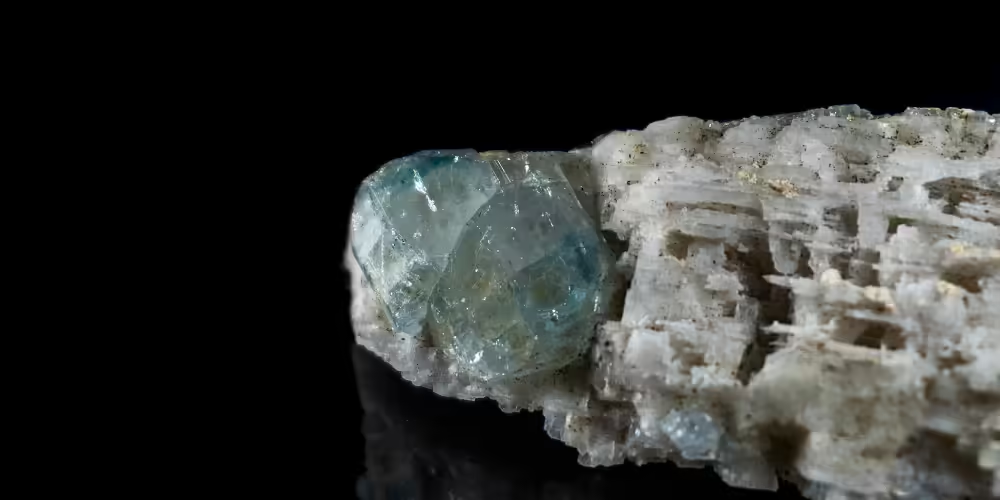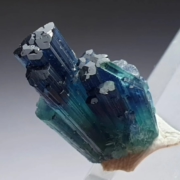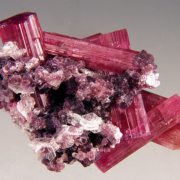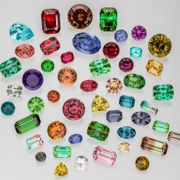Indicolite: Properties, Uses and Virtues
Indicolite: The Deep Blue of Tourmaline
Indicolite is a captivating colour variation of Elbaite, which itself belongs to the fascinating family of tourmaline gems. Gem lovers and jewellery enthusiasts will be enchanted by its dazzling blue hue and exquisite sparkle.
In this journey into the world of Indicolite, we explore its geological formation, the raw beauty of its uncut crystals, its diverse global sources and its significant role throughout history. Discover the metaphysical properties, colour variations, unrivalled durability and maintenance requirements of Indicolite.
Discover the secrets of natural Indicolite and explore the fascinating world of synthetic counterfeits, enabling you to identify genuine gems on the market with complete confidence.

Indicolite: Table of contents
- Indicolite Geological Formation
- Rough Indicolite – Raw Beauty
- Sources – The Worldwide Scope of Indicolite
- Historical Significance of Indicolite – Through the Ages
- Metaphysical properties of Indicolite – Illuminating energies
- Varieties of Indicolite
- Indicolite colors
- Durability and Wearability of Indicolite
- Indicolite Improvements – Preserving natural beauty
- Synthetic Indicolite – Nature in the Laboratory
- Imitations of the Indicolite – Discerning the Authentic
- Indicolite Care – Preserving natural beauty
Indicolite Geological Formation
Indicolite, the blue variety of Elbaite, forms in specific geological conditions, mainly in metamorphic rocks or pegmatites. The interaction of minerals, subjected to intense heat and deep pressure in the earth’s crust, gives rise to the bewitching blue hues of Indicolite tourmaline.
Rough Indicolite – Raw Beauty
The charm of uncut Indicolite crystals lies in the complex and exceptional structure displayed by these crystals, which have a distinct prismatic shape adorned with 3, 6 or 9 faces.
In particular, Indicolite crystals often display intense pleochroism, revealing different colours depending on the angle from which they are viewed, enhancing their raw beauty.
Sources – The Worldwide Scope of Indicolite
Indicolite, with its global presence, can be found in different regions around the world. Indicolite’s major sources include Brazil, Madagascar, Afghanistan and the United States.
Each location contributes distinct nuances and qualities, making Indicolite a highly sought-after gemstone cherished by cultures the world over.
Historical Significance of Indicolite – Through the Ages
Indicolite, a blue variation of Elbaite tourmaline, has a mysterious historical significance that is difficult to define definitively.
Although it is highly likely that Indicolite was used and revered in ancient times for its striking blue colour, tracing its exact historical journey is complicated by the fact that many gemstones were often confused with each other at the time.
Indicolite’s enchanting blue hue suggests that it may have been prized and valued by ancient civilisations for its calming, serene qualities.
Like many gems from this period, Indicolite may have been associated with spiritual significance and considered a stone of protection and inner peace.
Metaphysical properties of Indicolite – Illuminating energies
Indicolite, like other varieties of tourmaline, has been attributed certain metaphysical properties. It is believed to improve communication, promote feelings of calm and encourage creativity.
It is also considered to be a stone of spiritual growth and healing, making it a precious stone appreciated by those seeking emotional balance and tranquillity.
Varieties of Indicolite
Indicolite tourmaline has no varieties to speak of.
Indicolite colors
Indicolite tourmaline captivates with its captivating range of blue shades, from delicate pastels to intense, rich blues. Each shade has its own unique charm, making Indicolite an exceptional choice for jewellers and collectors who appreciate its infinite appeal.
Indicolite is often confused with Paraiba, although their colours are different.
Paraiba has violet tones in its blue-green and very bright hues. It is also much rarer and more precious.
Paraiba also owes its colour to copper and manganese, while Indicolite owes its colour to iron.
Durability and Wearability of Indicolite
Indicolite has excellent hardness and durability, ranging from 7 to 7.5 on the Mohs scale. It is therefore ideally suited to a variety of jewellery designs, ensuring that its enduring beauty can be cherished for generations.
Indicolite Improvements – Preserving natural beauty
Heat treatment: In the case of Indicolite, the heat treatment process involves subjecting the green or dark blue tourmaline to controlled heat. This treatment aims to eliminate or reduce certain elements or impurities responsible for the green or dark blue colour, thus lightening the stone and revealing a more vibrant and desirable blue hue.
As with any gem enhancement, it is essential that reputable retailers disclose the use of heat treatment to maintain transparency and enable consumers to make informed choices when purchasing Indicolite or any other heat-treated gemstone.
Proper disclosure also ensures that the value and authenticity of the gemstone is accurately represented on the market.
Synthetic Indicolite – Nature in the Laboratory
Synthetic tourmaline is notoriously difficult and expensive to create. In this case, synthetic tourmalines are rarely created.
Most of the ‘synthetics’ on the market are simulants or artificial materials.
Imitations of the Indicolite – Discerning the Authentic
Due to the popularity of Indicolite, it can sometimes be imitated or misrepresented on the market by many blue stones such as blue topaz, synthetic spinel or glass.
Buyers should exercise caution and seek out reputable sources to ensure they are acquiring genuine Indicolite gems.
Indicolite Care – Preserving natural beauty
To care for your Indicolite jewellery, clean it gently with a soft brush and mild soapy water, avoiding harsh chemicals.
Protect them from extreme temperatures and store them separately to avoid scratches.
To avoid chemical damage, avoid exposing them to household cleaning products, perfumes or hairspray.
Avoid mechanical cleaning. Regularly check settings to ensure safe placement and consider professional cleaning and inspection.
When you’re not wearing them, store them in a box or compartment lined with soft fabric and avoid unnecessary physical impact.





Leave a Reply
Want to join the discussion?Feel free to contribute!